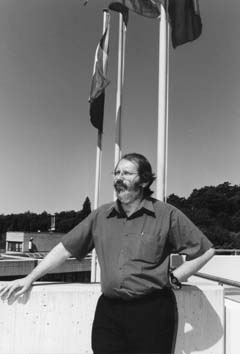Personal tools
News from ICTP 94 - Profile

A new book, co-authored by ICTP Associate Joseph C. Várilly, to be published this fall, seeks to explain the principles of noncommutative geometry to both mathematicians and physicists.
Crossing Cultures, Spanning Disciplines

Newly appointed ICTP Associate Joseph C. Várilly has been a professor of mathematics at the University of Costa Rica for more than 20 years. But that hasn't thinned his Irish blood or softened his Irish character. Even when the lilt in his accent doesn't give him away, his easy-going story telling and self-deprecating humour does.
Várilly's journey from the isle of Ireland to the isthmus
of Costa Rica began about 30 years ago in Dublin, where he earned
his bachelor's degree in science from University College in 1973.
Várilly was then accepted at the University of Rochester
in the United States for graduate studies in mathematics. Gérard
G. Emch was his major professor; quantum statistical mathematics
his major research field.
While working towards his doctorate degree, which he earned in
1980, Várilly spent a year at the University of Campinas
in Brazil. There he met a Costa Rican woman. "The rest,"
Várilly says, "is history." In 1979, he moved
to his wife's native country, where he has been ever since.
Várilly's research has unfolded across a broad field of
topics all related to quantum theory. In the late 1980s, he concentrated
on phase-space methods in quantum mechanics; in the early 1990s,
symmetries in quantum field theory; and for the past eight years,
noncommutative geometry and its physical applications. Each of
his specialised research areas has reached beyond mathematics
to physics. As Várilly notes, "theoretical physicists
have expressed as much interest in my work as my colleagues in
mathematics."
In fact, the interest that theoretical physicists have shown towards
noncommutative geometry has largely driven his latest project:
a 'primer' on the subject written in part for theoretical physicists
who would like to know more about the concept as a way to better
understand quantum space-time.
As Várilly explains: "Less than a decade ago, the
great French mathematician and Fields Medal winner Alain Connes
almost single-handedly invented the subject of noncommutative
geometry. The book he wrote, Noncommutative Geometry, remains
the field's main reference. But it is a compilation of research
papers, which make for difficult reading even for colleagues in
related fields. The book I have co-authored, which is descriptively
titled Elements of Noncommutative Geometry," Várilly
says, "is one that mathematicians and theoretical physicists
should read before they read Connes' book."
Elements of Noncommutative Geometry, scheduled to be published
this fall by the well-respected science publisher Birkhäuser,
will be distributed world-wide. Várilly and his co-authors,
José M. Gracia-Bondía and Héctor Figueroa,
who are his colleagues at the University of Costa Rica, hope to
reach a wide range of scientists and mathematicians with their
book. "Noncommutative geometry," the authors note in
the book's preface, offers "a bouquet of applications related
to analyses of the standard model, the quantum Hall effect, string
theory and renormalisation."
Várilly says that it should be no surprise that many of
his articles are written with other physicists, particularly his
long-time colleague Gracia-Bondía. "Science has increasingly
become a collaborative enterprise as the lines between disciplines,
particularly mathematics and physics, continue to blur. Collaboration,"
he adds, "is particularly important to researchers from the
developing world. Teamwork helps break our isolation and expands
our range of contacts."
With his new book in press, Várilly, appointed an ICTP
Associate in 1998, arrived in Trieste in June "to see what's
next." He is particularly interested in exploring the interface
of noncommutative geometry with quantum field theory, especially
the role that Hopf algebras play in symmetries. "My new avenue
of inquiry remains focussed on areas where mathematics can speak
directly to physical phenomena. I hope that both mathematicians
and physicists continue to find my research and writing useful."
"I first visited the Centre in 1985 to participate in the
College on Representation Theory of Lie Groups and that really
got me going as a researcher. Now with my appointment as an Associate,
the Centre should serve as my research retreat for the next several
years. I plan to put this opportunity to good use."
His visits to Trieste, Várilly says, will help energise
and direct his research, which will continue to take place largely
in Costa Rica. To confirm his commitment to his adopted homeland,
Várilly quoted a saying often heard in Spain. "Uno
nace donde quiere," he observes in his Irish-lilted Spanish,
"pero se muere en el pueblo de su mujer." The
English translation: "A man is born wherever he likes, but
he always dies in his wife's village."